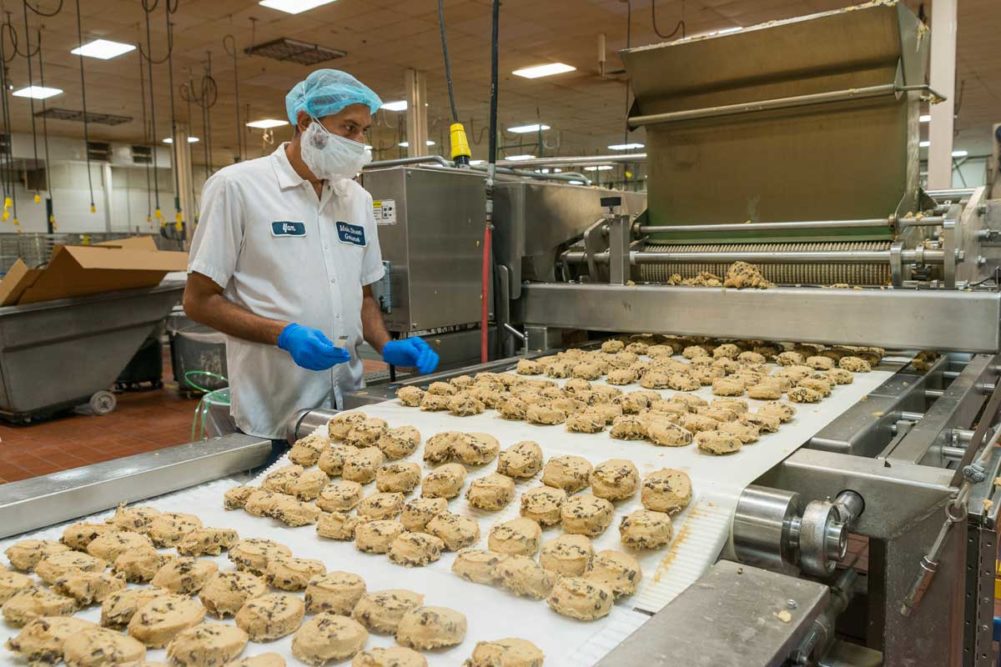|
|
Becoming a custom bakery demanded flexibility to adapt to various customers’ needs. Much of the equipment on Main Street Gourmet’s production room floor is modular so it can be moved around. The bakery employs the 5S principles for streamlining that process.
“Our plant floor is laid out with locations for equipment storage because part of our versatility is having a lot of equipment that can’t just be lying around,” said Roger Mitchell, director of operations for the Akron, Ohio-based bakery.
The bakery also uses a process recipe system that indicates which pieces of equipment are required for the current production schedule. This method avoids issues of multiple lines demanding the same piece of equipment at the same time.
“It’s very clearly delineated what is needed on the line as far as pieces of equipment,” Mr. Mitchell explained.
The 70,000-square-foot facility encompasses offices, six production lines, a dry ingredient warehouse, freezer, cooler, packaging department and loading docks.
Typically, it is operated in two, 10-hour shifts, but depending on weekly production and season demand, the bakery could be running 24/7.
While the production lines are very versatile, the plant features three batter lines, one cookie line and two bakery lines. Bakery production produces finished baked goods like muffins, brownies, bars and granola.
All products begin a single mixing room where 200-qt Middleby Bakery Group Varimix vertical mixers and 400- to 1,500-lbs CMC Champion horizontal mixers incorporate ingredients for the batters and doughs. Ingredients are stored in totes and 50-lb bags and manually scaled.
All incoming ingredients are labeled and stored by allergen and lot number and entered into the ERP system for traceability and food safety. Finished doughs and batters are manually transferred to one of the six production lines.
The batter line deposits muffin and cake batter, pie fillings, and icings into bags, buckets or muffin cups to be frozen. Hinds-Bock and Reiser Vemag depositors are swapped out to portion the variety of products on this line. Being able to change the depositors not only enables a wide range of deposit sizes but also optimizes the depositor for each specific product.
[Related listening: The novel approach behind Main Street Gourmet’s employee recruitment strategy]
On the cookie line, a Unifiller cookie depositor cuts cookie pucks and places them onto a belt that is then pulled through a 20-foot-long Air Products nitrogen freezer tunnel before being boxed in either retail or foodservice packaging.
On the bakery lines, a Goodway depositor portions batter or dough at up to 1,500 lbs an hour, depending on the weight of the deposit. The bakery line also includes a battery of 10 Baxter double rack ovens for more flexibility, with bake times ranging from 15 to 75 minutes.
“You can make muffins, brownies and bars all at the same time because we can set the ovens’ times and temperatures independently,” Mr. Mitchell said.
After baking, products are cooled on racks and then either topped by a Unifiller topper, if necessary, or sent straight to packaging. The Unifiller topper can apply streusel, fruit or even caramel. Brownies are sliced in a tray by an automated FoodTools Sonic cutter before being packaged.
An MSG inline clamshell denester automates clamshell packaging for muffins. Every finished and packaged product goes through Loma Systems and Eriez metal detection. Packaged product is then stored in the freezer or cooler until distributors pick it up.
In 2017, Main Street Gourmet expanded its current facility to gain more room for production. Landlocked in three directions, the bakery built a 15,000-square-foot warehouse in the only direction it could. This expansion freed up much-needed new production. Main Street filled that new-found area with more Baxter ovens and plant infrastructure.
This article is an excerpt from the November 2020 issue of Baking & Snack. To read the entire feature on Main Street Gourmet, click here.






